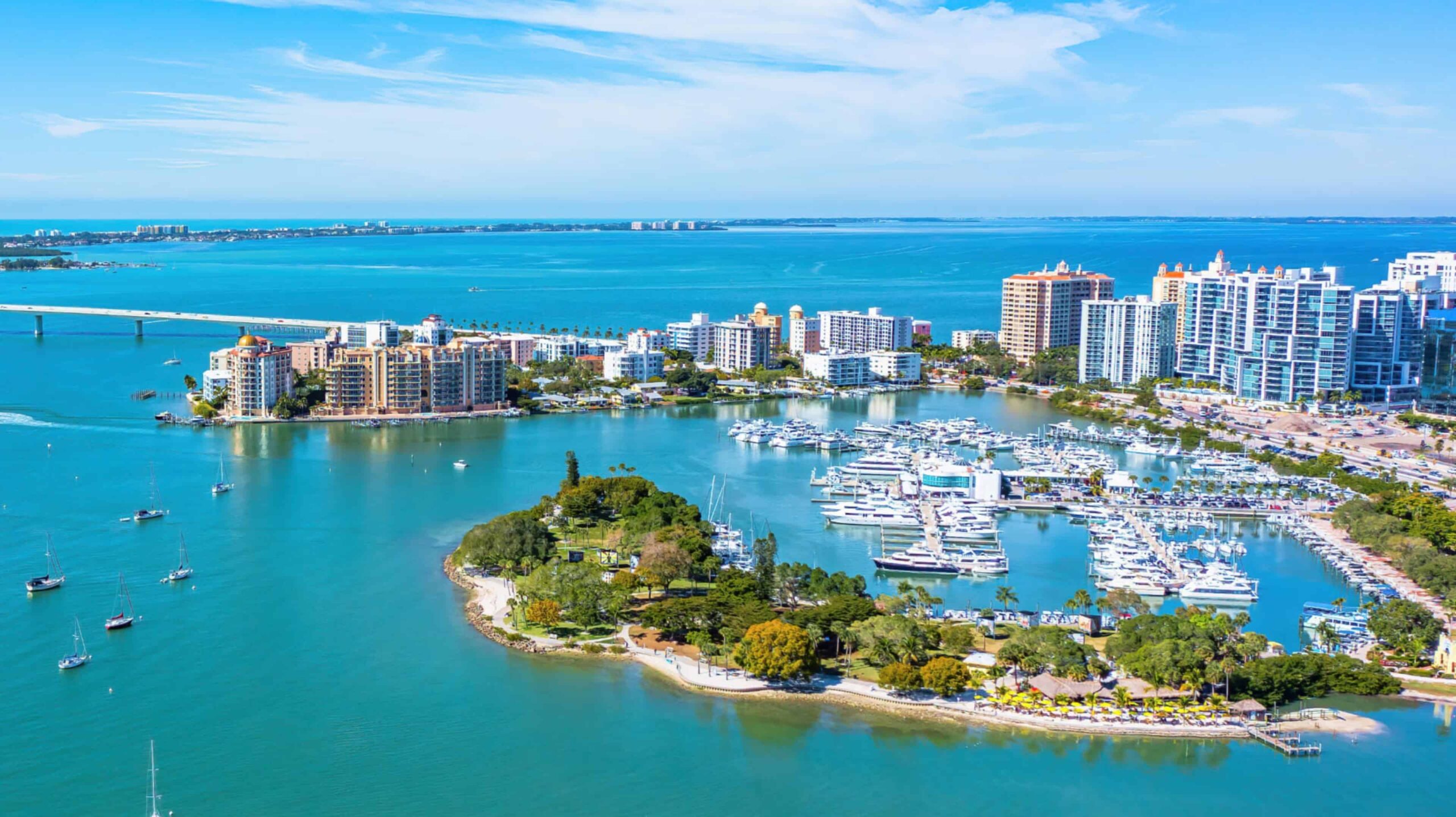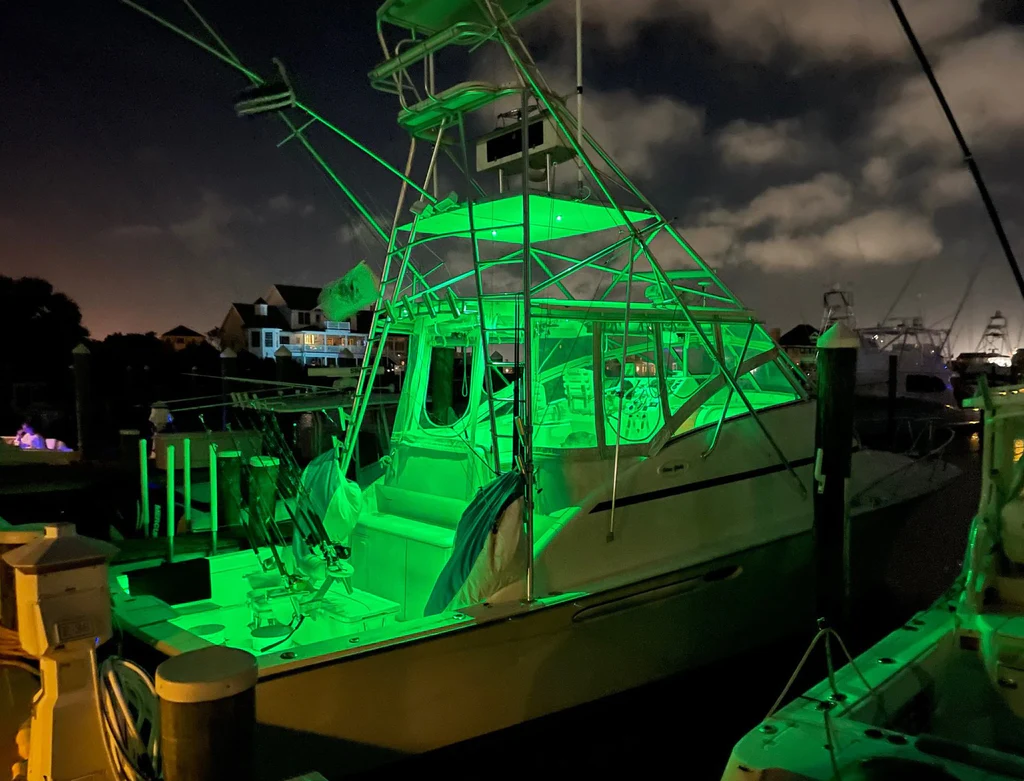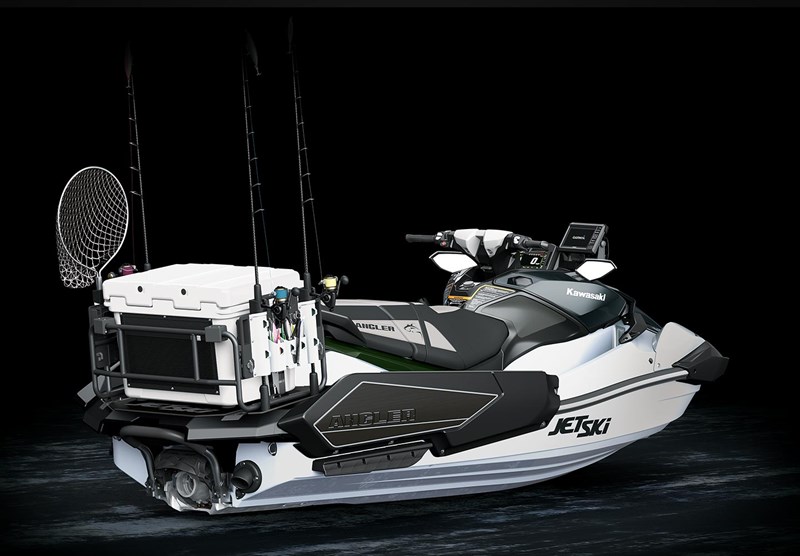Parts of a Ship: Essential Components Explained
Ships have long been an essential part of global trade and transportation. These complex structures consist of numerous parts, each playing a vital role in ensuring a vessel's functionality and efficiency. Understanding the different components of a ship not only helps maritime professionals, but also gives boat enthusiasts, hobbyists, and even casual travelers a better appreciation for the intricacies of these impressive machines.

At the heart of every ship lies its hull, which provides buoyancy and supports the vessel's overall structure. On top of the hull, various deck structures serve as working areas, carrying cargo, and housing essential ship facilities. Masts and derricks support sails and contribute to the ship's stability, while the navigation and control room allow crews to safely steer the vessel through all types of weather conditions. Together, these components contribute to the reliable and efficient operation of the ship.
Furthermore, engine and propulsion systems power the movement of a ship, while the ship's accommodation areas house its personnel and provide comfort and safety on long voyages. Each ship also has specialized parts, stability features, and essential facilities to support crew and cargo operations and management.

Key Takeaways
- Ships consist of numerous components, with the hull and deck structures being critical to their structure and function.
- The navigation and control room, engine and propulsion systems, and various masts and derricks contribute to the safe and efficient operation of a ship.
- Ship accommodations and specialized parts, stability features, and facilities support both crew and cargo operations and management.
Hull
The hull of a ship is the main floating body and the most noticeable part of any vessel. It serves as a watertight enclosure that protects the cargo, machinery, and accommodation spaces from weather, flooding, and structural damage. The hull's design is essential in providing buoyancy and keeping the ship afloat by displacing water, according to Archimedes' principle.
At the front of the hull, you will find the stem, which is the forward part of the ship connecting the sides of the hull. The forecastle is a raised deck located at the bow, which contributes to the vessel's stability and provides space for crew members or storage. On many modern ships, especially larger vessels, a bulbous bow protrudes below the waterline, which helps reduce drag and improve fuel efficiency.

The stern of a ship is the rear part of the hull and is typically shaped to minimize turbulence and drag. It also houses the propeller, rudder, and other essential equipment for steering and maneuvering the vessel.
There are several visible parts of a ship's hull, such as the bow, stern, forecastle, and the side shell. The side shell is the outer plating on the sides of the ship, which provides structural strength and protects the vessel from damage. Other critical components, such as bulkheads, double bottom, and the ship's internal framework, are not visible from the outside but are crucial elements of the hull structure.
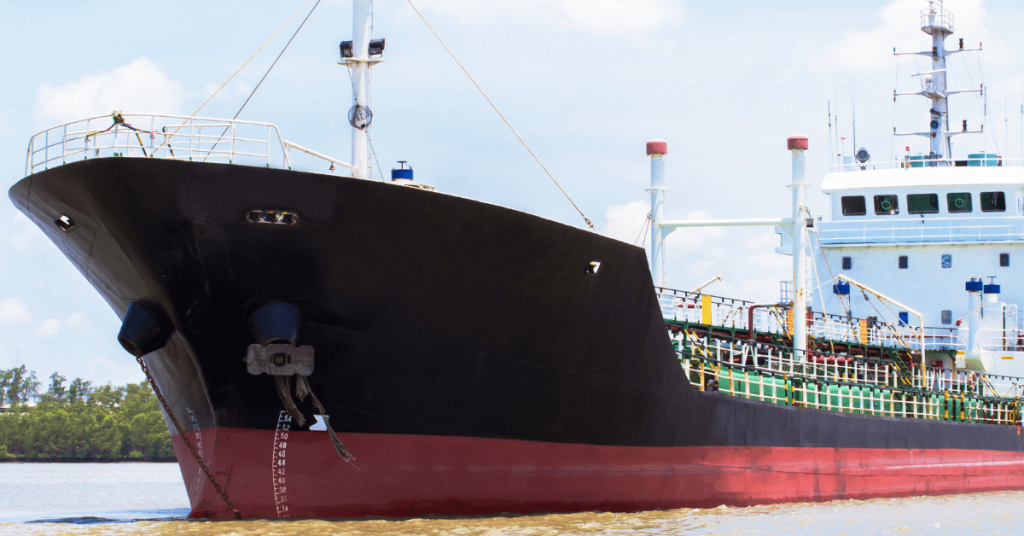
Bulkheads are vertical partitions that separate various compartments within the ship, providing both stability and watertight integrity. The double bottom refers to the area between the outer hull plating and the inner layer of the hull, which offers additional protection to the ship's machinery and cargo in case of damage to the outer layer.
Each of these components plays a vital role in the design and functionality of a ship's hull, ensuring the vessel's safety, stability, and performance in various conditions. The importance of understanding and maintaining the hull and its related parts cannot be overstated, as they are crucial to the overall success and survivability of any maritime endeavor.

Deck Structure
The deck structure of a ship is a crucial component that provides stability, walking space, and a place for equipment and machinery. It consists of various types of decks, each with specific functions and characteristics. This section will discuss the main deck, upper deck, foredeck, weather deck, lower deck, bridge, funnel, and stock.
The main deck is a ship's primary horizontal surface and is often synonymous with the weather deck. The weather deck is the uppermost full-length deck that is exposed to the elements. It serves as a working area for crew members and provides access to various parts of the ship.
Located above the main deck is the upper deck. This area may contain additional equipment, such as lifeboats and navigation instruments, or provide extra space for recreational activities and passenger accommodations on larger vessels.
The foredeck is situated at the forward part of the ship and is typically used for anchor handling and mooring activities. It can also provide storage for spare gear and equipment.
The lower deck, also referred to as the "tween" deck, is situated below the main deck of the ship. It often houses the engine room, as well as cargo storage and crew sleeping quarters. The lower deck may also contain essential systems like ventilation and electrical components.
The bridge is an elevated platform that holds the ship's primary navigation and control systems. The officer of the deck can be found here, overseeing the ship's overall operations. The bridge may also include communication equipment, radar, and other essential instruments.
A ship's funnel is a large vertical structure that houses the exhaust system for the vessel's engine. It expels smoke and gases produced during combustion and helps regulate air pressure within the engine room.
Lastly, the term "stock" often refers to the vertical part of the anchor that helps hold it in place. It is essential for providing stability when the ship is moored or anchored.
In conclusion, the deck structure of a ship is vital for its functionality, stability, and overall operation. Each deck and component has its specific purpose, ensuring the smooth and efficient running of the vessel.
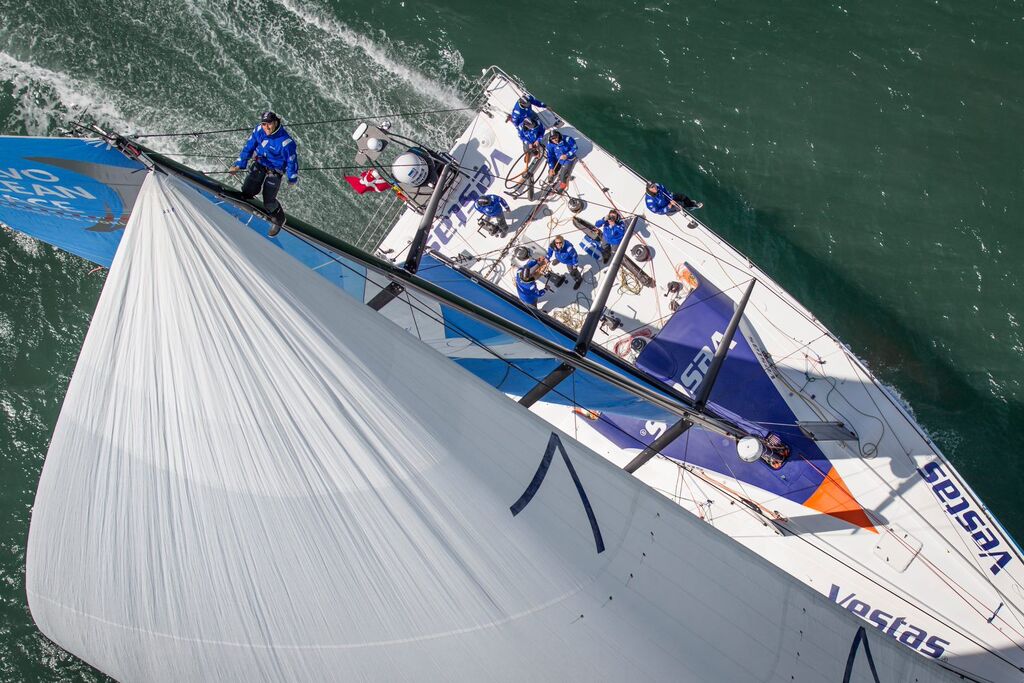
Masts and Derricks
Masts are essential components of a ship's structure and typically serve various purposes, including supporting sails, flags, and navigation equipment. There are different types of masts in a ship: the main mast, located near the center, and the foremast, closer to the bow. Masts are generally the largest vertical structures on a vessel's deck and, in case of cargo ships, can have derricks or cranes on top, increasing their height.
Derricks, on the other hand, are a type of lifting equipment used mainly on cargo ships for loading and unloading purposes. They consist of at least two components: a guyed mast or self-supporting tower, and a boom hinged at its base to provide articulation. These lifting devices can be controlled using three or four lines connected to the top of the mast, allowing for lateral movement and the ability to cant up and down.
One of the significant differences between masts and derricks is their functions. While masts are primarily for supporting equipment and sails, derricks are primarily for lifting heavy goods and cargo. However, it is common for the two to be combined on cargo ships, with derricks mounted on the masts to utilize the height advantage.
In the context of shipbuilding, each type of vessel may have specific configurations of masts and derricks depending on its purpose. For instance, sailing ships predominantly focus on the mast structure for proper sail management and navigation, whereas cargo ships prioritize derrick systems for efficient cargo handling.
To summarize, masts and derricks are crucial elements in a ship's structure, serving different purposes depending on the vessel type. Masts provide essential support for sails and equipment, while derricks facilitate cargo handling on cargo ships. Both structures play a significant role in the efficient operation and overall functionality of a ship.
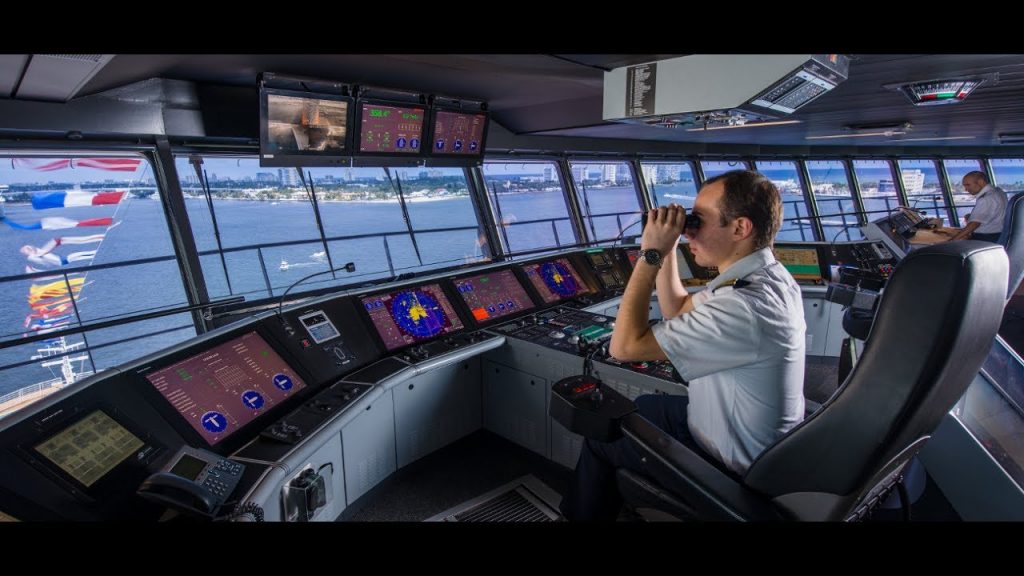
Navigation and Control Room
The navigation and control room, often referred to as the navigation bridge, serves as the central command center for a ship. From this location, the captain and officers are able to oversee and manage the entire operation of the vessel, ensuring safe and efficient navigation.
The bridge is typically situated in a position with an unrestricted view, allowing for greater visibility and immediate access to essential areas of the ship. Within the navigation and control room, several crucial components enable proper functioning and control, such as:
- Rudder: The rudder is a pivotal aspect of a ship's steering system, located at the stern. As the primary means for directing and altering the course of a vessel, the rudder functions by creating hydrodynamic forces when the ship is in motion, thus controlling its direction.
- Steering System: A ship's steering system enables it to maintain its desired course by adjusting the angle of the rudder. This system typically includes various components such as a steering gear, rudder angle indicators, and helm control.
- Navigation Bridge: This vital area contains a multitude of instruments and technology used to chart the ship's course and position. The navigation bridge encompasses advanced systems, such as radars, GPS, echo sounders, and Automatic Identification Systems (AIS), which aid in the safe and effective operation of the vessel.
- Bridge Wing: The bridge wing is an extension of the navigation bridge, generally located on the port and starboard sides. These wings provide improved situational awareness for the crew, thanks to their vantage point and direct visual access to the ship's sides. Bridge wings also house specialized controls and navigation equipment.
In summary, the navigation and control room is an essential part of any ship, equipped with the necessary systems and components for maneuvering and directing the vessel safely. The combined functionality of the rudder, steering system, navigation bridge, and bridge wings enables precise and accurate control over the ship's movements, ensuring efficient voyages and successful arrivals at their destinations.
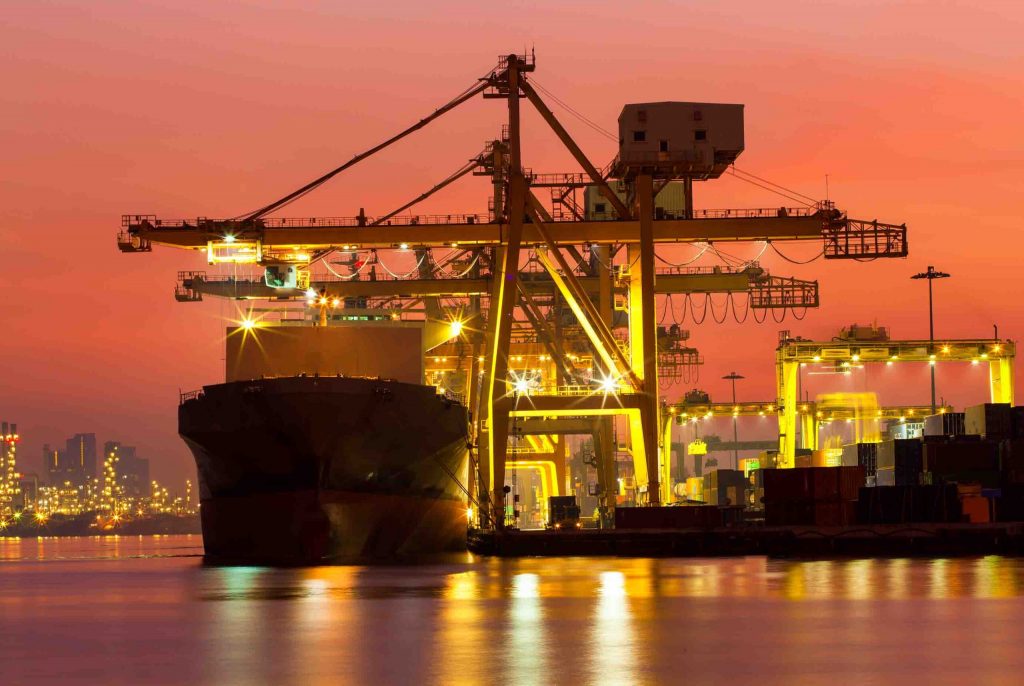
Cargo Operations and Management
Cargo operations involve the loading, stowage, securing, and unloading of goods on a ship. Managing these processes efficiently is crucial for ensuring timely deliveries and minimizing operational costs. In this section, we will discuss various aspects of cargo operations and management on ships.
One of the primary components of cargo operations is the use of cranes to load and unload cargo. These cranes are specifically designed for lifting heavy loads and can be found in various types, such as gantry cranes and onboard cranes. They play a vital role in handling cargo, particularly in situations where containers need to be lifted from the quayside onto the vessel, and vice versa.
The cargo hold is another essential part of a ship, responsible for housing the goods being transported. It is divided into several compartments, known as cargo holds, which can be adapted to accommodate different types of cargo, such as bulk, containerized, or general cargo. Hatch covers are used to close off the top of the cargo holds, protecting the cargo from the elements and ensuring that it remains safely stored during the voyage.
Proper planning and execution of cargo stowage are essential for maintaining the stability and safety of the vessel. This includes considering factors such as the weight and distribution of the cargo, the presence of hazardous materials, and the compatibility of different cargo types within the same hold. Additionally, securing the cargo is necessary to prevent any movement or shifting during the journey, which could potentially cause damage to the goods or even compromise the stability of the ship.
Handling containers is a significant part of cargo operations for many ships, as they provide a convenient and efficient method for loading and transporting various goods. Containers, often made of steel or aluminum, come in standard sizes to facilitate easy handling and stacking. Special equipment, such as container spreaders, is used to latch onto the containers' corners and lift them onto or off the ship.
In conclusion, cargo operations and management involve several key elements, such as cranes, cargo holds, hatch covers, and containers, to ensure the safe and efficient transportation of goods by ship. Proper planning, stowage, and securing practices are essential for maintaining vessel stability and delivering cargo without damage or delay.

Engine and Propulsion
Marine engines and propulsion systems play a crucial role in providing power to move ships through the water. The primary components of a ship's propulsion system include the engine, located in the engine room, and the propeller. These elements work in unison to overcome the water's resistance and achieve the desired speed.
Modern ships typically use mechanical systems driven by an electric motor or an internal combustion engine. These engines are designed to power the propellers or, in some cases, impellers in pump-jets. The design of propellers aims to optimize their efficiency, maintaining the balance between power and resistance.
There are two main types of marine engines: 2-stroke and 4-stroke engines. A 2-stroke engine is more commonly found in larger ships since it can generate more power, while a 4-stroke engine is used in smaller vessels. The choice of engine type depends on the specific requirements of each ship.
In addition to forward propulsion, marine engines also provide the ability to move the ship astern, or in reverse. This functionality is vital for maneuvering the ship and maneuvering in tight spaces, such as docking and undocking procedures.
In summary, the engine and propulsion system of a ship are critical for its efficient and safe operation. By overcoming water resistance and delivering the necessary power to the propellers, these systems enable ships to traverse vast distances at various speeds, while also allowing for precise control and maneuverability.

Ship Accommodation
Ship accommodation refers to the living spaces aboard a vessel, designed for the comfort and well-being of the crew. These areas include various rooms and facilities where crew members work, rest, and socialize.
Cabins are an essential feature of ship accommodation, providing individual living quarters for crew members. They come in different sizes and levels of comfort, depending on the rank and role of the occupants. Private cabins are commonly reserved for higher-ranking officers, while shared cabins are usually allocated to ordinary crew members.
The galley, or ship's kitchen, is another crucial component of the accommodation area. It's where meals are prepared and served to the crew. Galleys are typically equipped with modern cooking appliances, storage spaces for provisions, and refrigeration systems to ensure food safety and preservation.
In addition to cabins and the galley, ship accommodation may also include offices for administrative tasks and management. Such spaces are dedicated to paperwork, planning, and communication with the shore-based offices.
A laundry area is also an important part of ship accommodation. This facility is designed to meet the crew's needs for washing, drying, and ironing their clothes and uniforms. Access to laundry services is crucial for maintaining hygiene and appearance standards on board.
For larger vessels, a hospital or infirmary is usually present in the accommodation area. This medical facility is equipped with first aid and emergency care essentials to attend to the health issues and medical needs of the crew while at sea.
Ship accommodation also caters to recreational needs by incorporating spaces like a salon, recreational rooms, or a gymnasium. These areas offer the crew opportunities to socialize, engage in leisure activities or exercise, ensuring their mental and physical well-being during long voyages.
Finally, a messroom is provided for the crew to dine together. This communal space is an essential part of ship accommodation, promoting camaraderie and fostering a sense of community among crew members.

Essential Ship Facilities
A modern ship requires various facilities to ensure smooth and efficient operation. Some of the essential ship facilities include systems for handling water, fuel, oil, air conditioning, sewage, and waste management. Additionally, a well-designed ship must have provisions for refrigeration, emergency power generation, and storage of vital supplies.
Water and fuel storage are crucial to a ship's operation. Water is essential for drinking, cooking, and hygiene, while fuel powers the vessel's engines and generators. Ships typically have dedicated bunker tanks for storing and managing these resources. These tanks are carefully designed to maintain the quality and availability of water and fuel, ensuring a seamless voyage.
Oil storage and handling is another essential aspect of marine engineering. Lubricating oils need to be stored and managed for engine maintenance, and waste oils should be processed in an environmentally responsible manner. One key aspect of oil management in ships is the sewage treatment plant. This facility manages wastewater generated on board, enabling the ship to comply with international regulations and prevent pollution.
Air conditioning and refrigeration systems are vital for the comfort and well-being of the crew and passengers aboard the ship. The air conditioning system maintains a comfortable and healthy environment, regulating temperature and airflow. The refrigeration system, on the other hand, is essential for preserving perishable goods and supplies during the voyage.
Emergency generator room is a crucial part of any ship, as it provides backup power in case of a failure in the main power supply. This room typically houses a diesel generator, which can supply power to essential systems like navigation, communication, and safety equipment.
Garbage management is a vital aspect of a ship's operation, as incorrect handling can lead to environmental hazards. Most ships have designated areas for storing and processing solid wastes, including a garbage treatment facility.
Lastly, a well-maintained ship requires a dedicated paint room for storing painting materials and equipment. Proper storage of these items helps prevent accidents, improves the ship's appearance, and protects the vessel's structure from corrosion and other damage.

Ship's Stability Features
Ship stability is a critical aspect of naval architecture, ensuring the safety of the ship, cargo, crew, and passengers. One of the most important structural features contributing to stability is the keel, which forms the backbone of the ship and runs along its centerline. The keel provides strength and rigidity to the ship's hull and acts as a counterweight to help maintain its balance.
Another key element in maintaining ship stability is the freeboard. This is the distance between the waterline and the main deck of the ship. The greater the freeboard, the more reserve buoyancy the ship has, allowing it to better handle rough seas and adverse weather conditions.
Ballast tanks play a significant role in maintaining a ship's stability. These tanks, filled with seawater, can be adjusted to alter the vessel's weight distribution, enabling it to remain balanced and stable. Ballast tanks are often positioned along the ship's sides or in the bilge area, ensuring that the weight is spread evenly throughout the ship.
The duct keel is another essential component of a ship's stability system. It is located beneath the cargo holds and runs along the ship's length. The purpose of a duct keel is to provide a passage for pipes and cables that service the ballast tanks and other equipment. It also contributes to the structural integrity of the vessel.
Frames are essential in distributing the ship's load evenly across its entire structure. They are spaced at regular intervals along the hull, providing transverse support and contributing to the vessel's overall strength and stability.
A hopper tank is often used in bulk carriers and serves to store cargo, such as dry bulk materials, that can be easily discharged through its bottom. They help distribute the load evenly across the ship and contribute to its stability during the voyage.
Cofferdams are integral to a ship's stability, particularly on vessels that transport hazardous or potentially harmful cargo. These narrow, empty spaces separate the ship's fuel tanks, boilers, or cargo compartments, providing a safety buffer in the event of a leak or spillage.
Finally, the ship's waterline is an essential factor when determining its stability. This is the line where the hull of a ship meets the water's surface. The positioning of the waterline helps naval architects understand the ship's displacement and ascertain the appropriate freeboard levels and ballast requirements to ensure safe and efficient operation.
In conclusion, various features work together to maintain a ship's stability, including the keel, freeboard, ballast tanks, duct keel, frames, hopper tank, cofferdams, and waterline. Understanding and implementing these components effectively is crucial to ensuring the safety and performance of the vessel.

Specialized Parts of the Ship
A ship consists of various components, each crucial for its functionality and safety. This section will discuss some specialized parts of the ship and their importance, focusing on their maneuverability, safety, and structure.
The anchor is an essential part of any vessel, used to hold the ship in place while at sea. Anchors come in different shapes and sizes, but a common feature is the fluke, which digs into the seabed to secure the ship. The anchor is connected to the bow of the ship, providing stability and safety during anchoring operations.
Bow thrusters are specialized propulsion devices located at the front of the ship, providing lateral thrust to assist in maneuvering. They help increase the ship's maneuverability, particularly during docking and undocking maneuvers. Bow thrusters are a vital part of a ship's safety systems, as they allow the captain to adjust the ship's position without relying solely on the main propulsion system.
The superstructure of a ship comprises all the visible non-hull parts extending above the deck. One key component of the superstructure is the bridge wing, which extends outwards from the sides of the bridge. These wings provide a clear line of sight for the crew to monitor the ship's surroundings, with particular emphasis on safe navigation and docking operations.
A traditional, raised platform at the rear of the ship is called the poop deck. The poop deck serves multiple purposes, including being a vantage point for crew members to monitor the ship's rear, as well as a place to store equipment, such as spare lifeboats.
The monkey island, found on larger ships, is a deck that sits above the ship's bridge. It provides an elevated lookout position, facilitating the ship's crew's ability to observe navigational markers, nearby vessels, and other important details more effectively than from the lower deck.
Ships often have several stacks or funnels, which are vertical pipes used to release exhaust gases from the ship's engines. Stacks are designed to expel these gases safely into the atmosphere while minimizing the impact on the ship's deck areas and crew living quarters.
Each of these specialized parts contributes to the overall safety, maneuverability, and functionality of the ship. Understanding the key components of a ship ensures a smoother and safer journey for both the crew and the vessel.

Crew and Personnel
On a ship, the crew and personnel are essential for maintaining smooth operations and ensuring the successful completion of the voyage. The crew can generally be divided into four main categories: the deck department, the engineering department, the steward's department, and other personnel 1.
The deck department is responsible for steering, keeping lookout, handling lines in docking and undocking, and performing at-sea maintenance on the hull and non-machinery components. Deck officers, who rank in the vessel's hierarchy, include the Master (Captain), Chief Officer, Second Officer, Third Officer, and Deck Cadet. The Master holds the supreme authority on board and commands the entire crew 2.
Meanwhile, the engineering department operates the machinery and performs at-sea maintenance on the ship's mechanical components. The department is led by the Chief Engineer and includes assistant engineers, motormen, and electricians. They ensure that all equipment is functioning correctly and address any issues that may arise during the voyage 3.
The steward's department plays a crucial role in maintaining the health and well-being of the crew. This department includes the Chief Steward, cooks, and other steward personnel. They prepare and serve meals, oversee sanitation, and manage the ship's inventory of food and other consumables 4.
In addition to these three primary departments, other specialized personnel may be present on board, depending on the type of vessel and its specific requirements. These professionals might include medics, communicators, and security officers, among others. All crew members, regardless of their position, work together to ensure the safe and efficient operation of the ship 5.
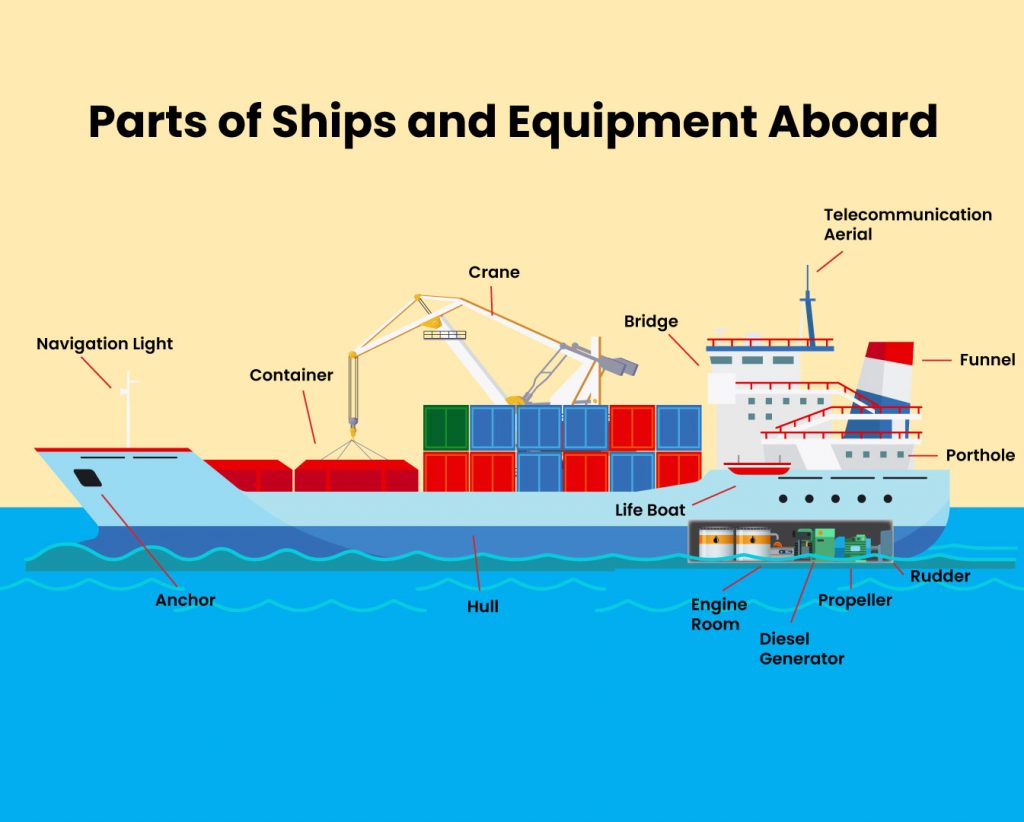
Frequently Asked Questions
What are the main components of a ship's deck?
A ship's deck is the horizontal surface that forms the top part of the vessel. Key components of a ship's deck include the deck plating, anchor, hatches, cleats, bollards, and the railing. The deck plating is the surface of the deck, often made of steel or another strong material. The anchor is used to secure the vessel in place when necessary. Hatches allow access to different compartments below the deck. Cleats and bollards are used for securing ropes and mooring lines, while the railing surrounds the deck's outer perimeter for safety purposes.
What are the key parts of a ship's hull?
The hull is the main structural body of a ship that provides buoyancy and protects the interior. Some key parts of a ship's hull include the bow, the stern, the keel, the bilge, and the plating. The bow is the forward-most part of the ship, designed to cut through the water efficiently. The stern is the rear section, which houses the rudder and propeller. The keel is a long, structural backbone that runs along the bottom to provide strength and stability. The bilge is the lowest part of the hull where water collects. The plating covers the hull, providing a barrier between the vessel and the water.
What are the different rooms on a ship called?
Rooms on a ship are typically called compartments. They can be classified into living quarters, operational spaces, and utility areas. Living quarters include cabins, mess rooms, and galleys. Operational spaces refer to areas like the bridge, engine room, and cargo holds. Utility areas include storage rooms, workshops, and machinery spaces.
What are the major parts of a sailing ship?
A sailing ship has several distinctive parts, such as the mast, sails, rigging, and rudder. The mast is the vertical structure that supports the sails. Sails are the large sheets of fabric that harness wind power to propel the ship. Rigging is a system of ropes and lines that control the positioning of the sails and mast. The rudder is a crucial part of the ship's steering system, helping to control direction.
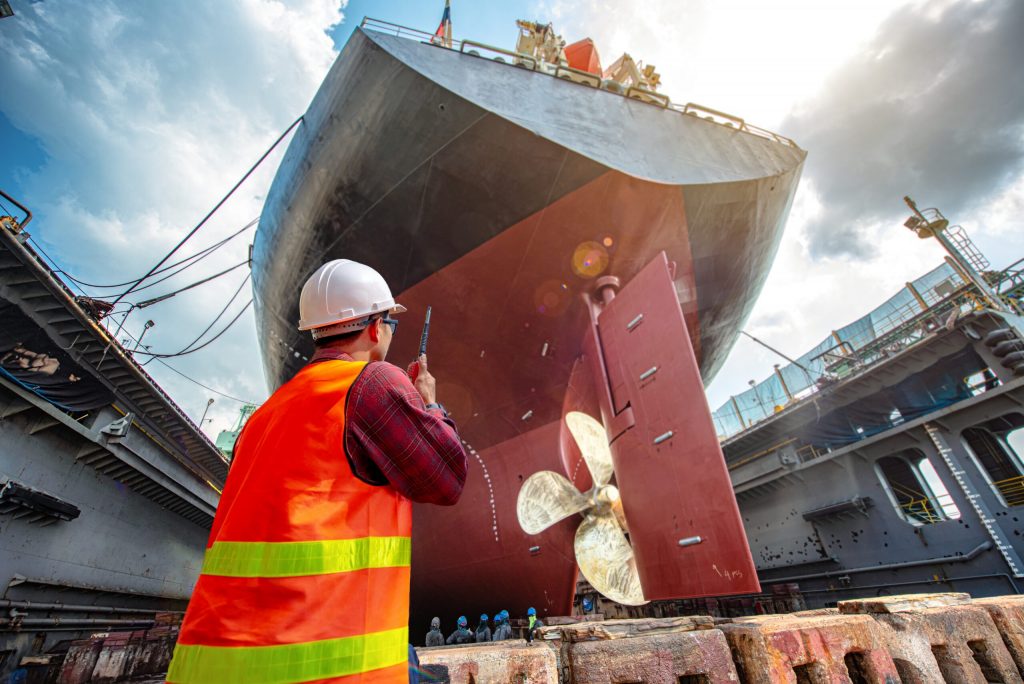
What are the components of a ship's stern?
The stern is the back end of the ship, and its components include the rudder, propeller, sternpost, and the transom. The rudder is a movable structure that helps steer the ship. The propeller generates thrust to move the vessel forward or in reverse. The sternpost is a vertical support providing structural reinforcement to the stern. The transom is the flat section at the rear of the hull, which provides additional stability and support.
What are the essential parts of a ship's mast?
A ship's mast plays a vital role in the vessel's sailing capabilities. Essential parts of a mast include the spar, the shrouds, stays, and spreaders. The spar is the main vertical support, often made of wood or metal. The shrouds are lateral cables or chains that provide additional stability. Stays are fore-and-aft cables, connecting the mast to the bow and stern. Spreaders are horizontal bars that help to evenly distribute tension from the shrouds and stays.

Q&A With MMI Marine Tech
Charlie, Sea Magazine (C): Good morning, Mike! It's a pleasure to have you with us today. I understand that as an expert at MMI Marine Tech, you can offer our readers a unique insight into the parts of a ship.
Mike, MMI Marine Tech (M): Good morning, Charlie. Thanks for having me. I'm happy to shed some light on the subject!
C: Let's dive right in. Can you explain the basic layout of a ship?
M: Certainly. Starting from the front, or the ship's bow, you would find yourself moving towards the ship forward. As you move aft, you'll cross the promenade deck and perhaps the lido deck, which is often a favorite among passengers.
C: And what about the back end?
M: The rear of the ship is called the stern deck. Just above it, you might see the deck house, while below the waterline, you'd find the ship's rudder connected to the rudder trunk. The rudder plays an essential role in navigation, and it's controlled by a sophisticated hinge system.
C: Interesting. And the propulsion?
M: Ships are typically powered by the ship's primary engine, which turns the ship's propeller or in some larger ships, multiple ship's propellers. This, combined with the rudder, allows the ship to move forward, turn, or even move the boat sideways.
C: I've often heard about the flush deck and uppermost deck. Could you explain those?
M: Absolutely. A flush deck is a continuous deck with no superstructure, while the uppermost deck is the highest deck on the ship, usually above the passenger cabins. Speaking of which, ships typically have separate crew cabins and passenger cabins.
C: Got it. Can you tell us a bit about the different types of ships?
M: Of course. There are lighter ships, which are generally smaller and more nimble. Naval vessels are part of the armed forces, while military vessels are specifically designed for warfare. Then, we have inland navigation vessels that are optimized for rivers and canals.
C: And how do they manage the weight and stability?
M: Ships use a ballast tank system to maintain stability. These tanks can be filled or emptied as needed to ensure the ship is balanced.
C: I've seen some ships with structures on the side. What are those?
M: Those are cargo booms. They assist in loading and unloading cargo. On the back, you might also notice the ship's transom, which is the flat surface that forms the stern of a ship.
C: Now, Mike, how do ships navigate and ensure they are on the right course?
M: Great question. Ships use a combination of modern technology and traditional methods like solar and stellar observations. Of course, tools like the ship's horn are crucial for signaling, especially in foggy conditions.
C: Before we wrap up, could you touch upon a few more parts?
M: Sure. The port side is the left side of the ship when facing forward. The ship's anchor helps secure the ship in place. Some ships also have a sewage treatment plant onboard to process waste. And for those curious about construction, ships are often built in complete hull sections which are then assembled.
Charlie, Sea Magazine (C): Mike, before we wrap up, there are some more specific terms our readers have shown interest in. I was hoping we could cover those as well.
Mike, MMI Marine Tech (M): Of course, Charlie. Go ahead!
C: First off, many of our readers are fans of luxury voyages. Can you tell us about the cruise ship?
M: Ah, the cruise ship. It's essentially a large passenger ship designed for pleasure voyages where the journey and the ship's amenities are part of the experience. On these ships, you'll find numerous decks, including the boat deck and the ship's upper deck. The topmost deck usually offers fantastic views and recreational facilities.
C: And when we talk about control, how is the rudder managed?
M: The rudder, which essentially determines the direction of the ship, pivots on the rudder carrier bearing. This, combined with the main rudder blade, is controlled by the steering gear system to manage the ship's direction.
C: Fascinating. With such a massive structure, how do they maintain the ship's speed?
M: The ship's speed is mainly determined by its primary engine's output and the efficiency of its propeller. But the ship's design, especially in ship construction, and its current load, like transporting cargo, play roles too.
C: Speaking of cargo, where is it typically stored?
M: Cargo is usually stored in an enclosed space within the ship's hull. This space is designed to hold all the equipment and goods securely during voyages.
C: How is safety ensured, especially during nighttime?
M: Safety is paramount at sea. Navigation lights are crucial as they signal the ship's position, direction, and status to other vessels, ensuring safe passage especially during low visibility or nighttime.
C: I've heard terms like paint room and quarter deck. What do they mean?
M: The paint room is a specialized compartment where paint and painting equipment are stored, ensuring safety and minimizing fume hazards. The quarter deck, on the other hand, is a part of the total deck length, traditionally where the ship's officers would mingle. It's usually situated at the aft of the ship.
C: Mike, it's been a wonderful session, and I believe our readers will benefit greatly from this conversation. Thank you for explaining these terms so comprehensively.
M: It's been my pleasure, Charlie. Always happy to share and enlighten. Safe voyages to you and your readers!
C: Till next time, Mike...hopefully we can finish discussing (Boat Forward & Ship Explained)!
Footnotes
- https://en.wikipedia.org/wiki/Seafarer%27s_professions_and_ranks ↩
- https://www.marineservices.ltd/blog/what-are-the-different-crew-positions-onboard-a-ship ↩
- https://www.britannica.com/technology/ship/Crewing ↩
- https://textbook.maritimemedicine.com/volumes/working-and-living-at-sea/4-3-positions-on-board.html ↩
- https://www.marineinsight.com/guidelines/parts-of-a-ship/ ↩
Charlie is Editor-in-Chief of Sea Magazine

